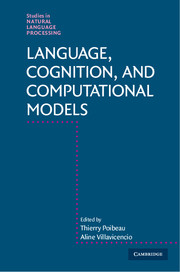Book contents
- Frontmatter
- Contents
- Figures
- Tables
- Contributors
- Part I About This Book
- Part II Models of Neural and Cognitive Processing
- Part III Data Driven Models
- 5 Putting Linguistics Back into Computational Linguistics
- 6 A Distributional Model of Verb-Specific Semantic Roles Inferences
- 7 Native Language Identification on EFCAMDAT
- 8 Evaluating Language Acquisition Models: A Utility-Based Look at Bayesian Segmentation
- Part IV Social and Language Evolution
- Index
- References
6 - A Distributional Model of Verb-Specific Semantic Roles Inferences
from Part III - Data Driven Models
Published online by Cambridge University Press: 30 November 2017
- Frontmatter
- Contents
- Figures
- Tables
- Contributors
- Part I About This Book
- Part II Models of Neural and Cognitive Processing
- Part III Data Driven Models
- 5 Putting Linguistics Back into Computational Linguistics
- 6 A Distributional Model of Verb-Specific Semantic Roles Inferences
- 7 Native Language Identification on EFCAMDAT
- 8 Evaluating Language Acquisition Models: A Utility-Based Look at Bayesian Segmentation
- Part IV Social and Language Evolution
- Index
- References
Summary
Abstract
In a standard view, commonly adopted in psycholinguistics and computational linguistics, thematic roles are approached as primitive entities able to represent the roles played by the arguments of a predicate. In theoretical linguistics, however, the inability to reach a consensus on a primitive set of semantic roles led to the proposal of new approaches in which thematic roles are better described as a bundle of more primitive entities (e.g., Dowty, 1991; Van Valin, 1999) or as structural configurations (e.g., Jackendoff, 1987). In a complementary way, psycholinguistic evidence supports the idea that thematic roles and nominal concepts are represented in similar ways (McRae et al., 1997b; Ferretti et al., 2001), thus suggesting that the former can be accounted for as predicate-specific bundles of inferences activated by the semantics of the verb (e.g., the patient of kill is typically alive before the event and dead afterward). Such inferences can take the form of either presuppositions or entailment relations activated when a filler saturates a specific argument position for a given predicate.
Our aim in this chapter is twofold. First, we report behavioral data collected to obtain a more fine-grained characterization of the thematic role properties activated by a subset of English verbs. To this end, we employed the modified version of the McRae et al. (1997b) elicitation paradigm proposed by Lebani et al. (2015) to describe which semantic properties of the participants are more relevant in each phase of the action described by the predicate. Next, we test the possibility to model such verb-specific inference patterns by exploiting corpus-based distributional data, thus proposing a novel approach to represent the same level of semantic knowledge that is currently described by means of a finite set of thematic roles.
Representing and Acquiring Thematic Roles
The concept of thematic role is one of the most vaguely defined, yet appealing, technical tools in the linguist's toolkit. Since its settlement in the circle of relevant modern theoretical issues, thanks to investigations by Tesnière (1959), Gruber (1965), Fillmore (1968), and Jackendoff (1972), this concept has been approached with what Dowty (1989) called the I-can't-define-it-but-I-know-itwhen- I-see-it stance; that is, by using it without offering a proper definition.
- Type
- Chapter
- Information
- Language, Cognition, and Computational Models , pp. 118 - 158Publisher: Cambridge University PressPrint publication year: 2018
References
- 1
- Cited by



